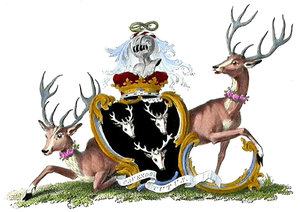William Cavendish, 3rd Duke of Devonshire

William Cavendish, 3rd Duke of Devonshire, KG, PC (26 September 1698 – 5 December 1755) was a British nobleman and Whig politician, the son of William Cavendish, 2nd Duke of Devonshire and the Hon. Rachel Russell.
Life
On 27 March 1718 he married Catherine Hoskins, or Hoskyn (died 8 May 1777). They had seven children:
- Lady Caroline Cavendish (22 May 1719 – 20 January 1760), who married William Ponsonby, 2nd Earl of Bessborough and had issue.
- William Cavendish, 4th Duke of Devonshire (1720 – 2 October 1764)
- Lord George Augustus Cavendish (died 2 May 1794), died unmarried.
- Lady Elizabeth Cavendish (born before 1727, died 1796), married John Ponsonby and had issue.
- Lady Rachel Cavendish (7 June 1727 - 8 May 1805),[1] who married Horatio Walpole, 1st Earl of Orford.
- Field Marshal Lord Frederick Cavendish (c. 1729 – 21 October 1803), died unmarried.
- Lord John Cavendish (c. 1734–1796)
Like his father, the 3rd Duke was active in public life. He was a Member of Parliament from 1721 until his father's death sent him to the House of Lords in 1729, and was made a Privy Counsellor in 1731. He served as Lord Privy Seal from 1731 to 1733, when he was invested as a Knight of the Garter. He later served for seven years as Lord Lieutenant of Ireland.[2]
He sold the Old Devonshire House at 48 Boswell Street, Theobald's Road, in Bloomsbury, and in 1734 engaged the architect William Kent to build a new Cavendish House in fashionable Piccadilly. In 1739, he was enlisted as a founding governor of a new children's charity, the Foundling Hospital in Bloomsbury, London, which aimed to alleviate the problem of infants being abandoned by destitute mothers and which later became a centre for art and music.
During the Jacobite rising of 1745 the Duke raised a militia unit in support of the King known as the Derbyshire Blues, which mustered at the George Inn, Derby, on 3 December 1745.
The Duke and his wife are also notable as the most recent common ancestors of Charles, Prince of Wales, and his first wife Lady Diana Spencer. Charles and Diana were seventh cousins once removed, as Charles is descended from the 3rd Duke's son, the 4th Duke, while Diana was descended from his daughter, Lady Elizabeth Cavendish.[3]
References
- ↑ Rachel Walpole, Countess of Orford at Geni.com
- ↑ "William Cavendish, 3rd Duke of Devonshire (1698 - 1755)". Chatsworth House. 27 March 2015. Retrieved 27 March 2015.
- ↑ "Diana, Princess of Wales: Frequently Asked Questions". www.dianapow.com. Retrieved 2016-08-07.

